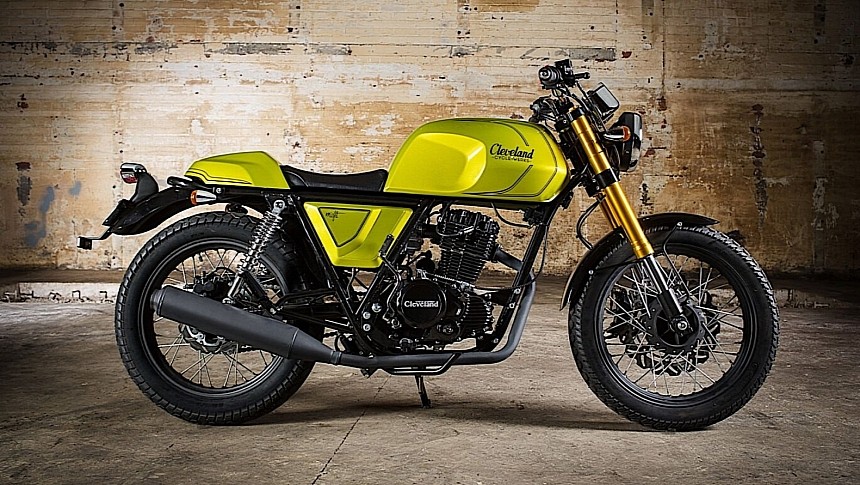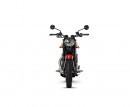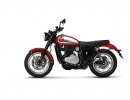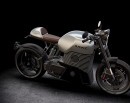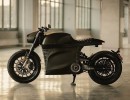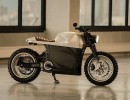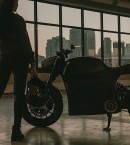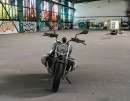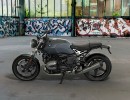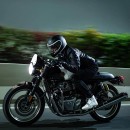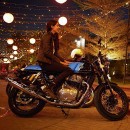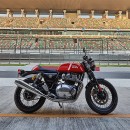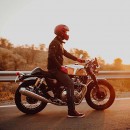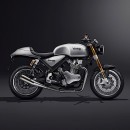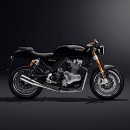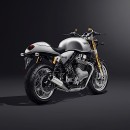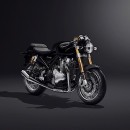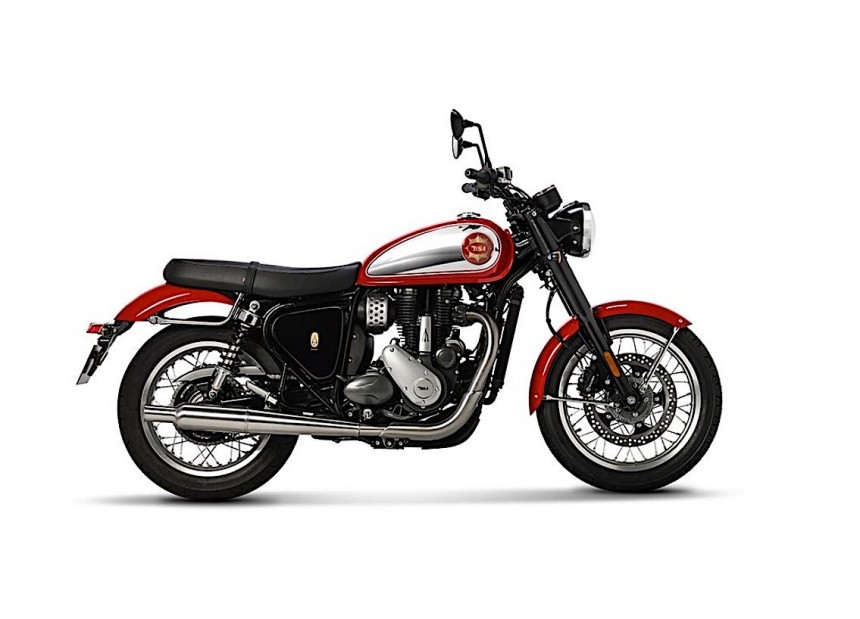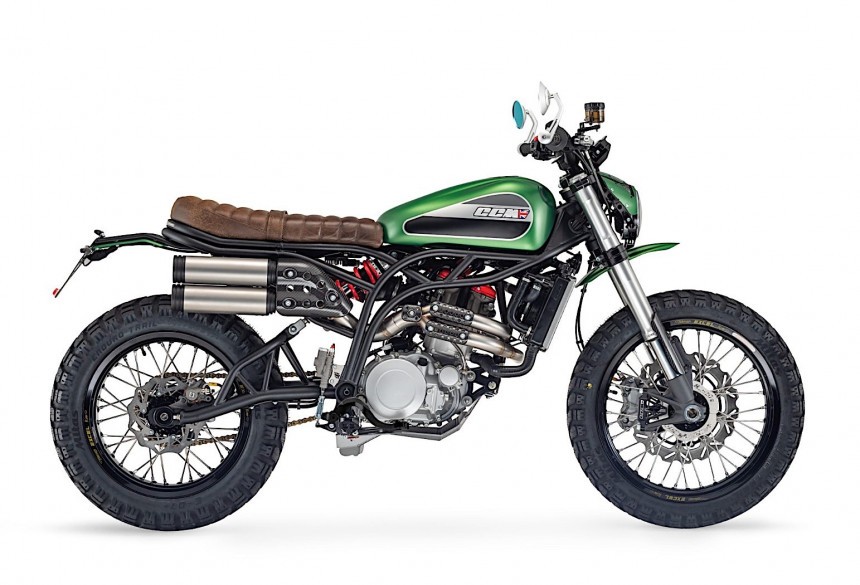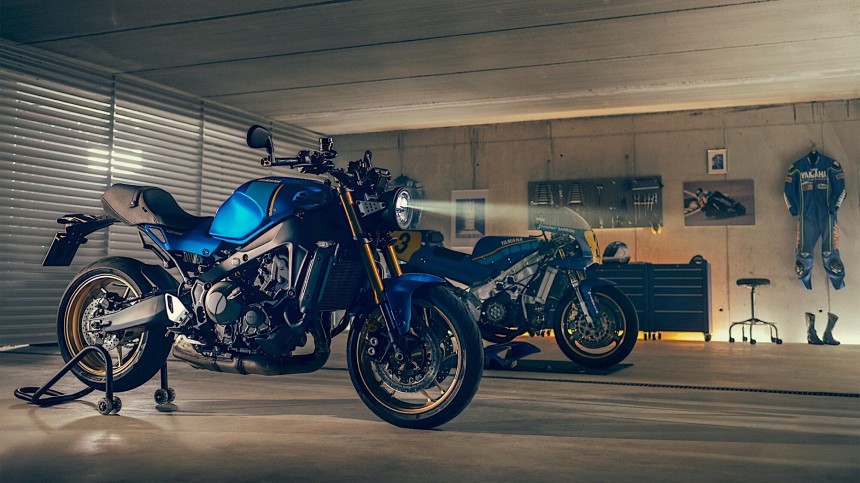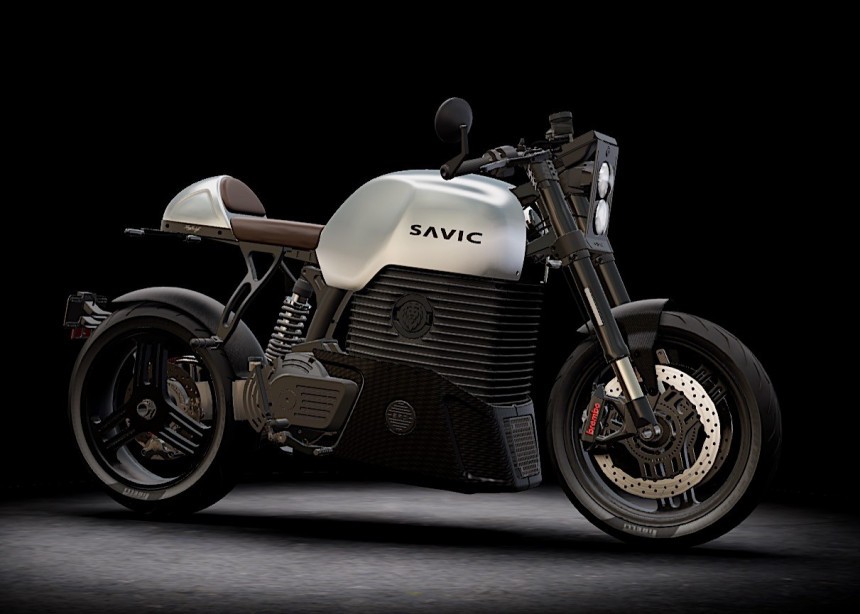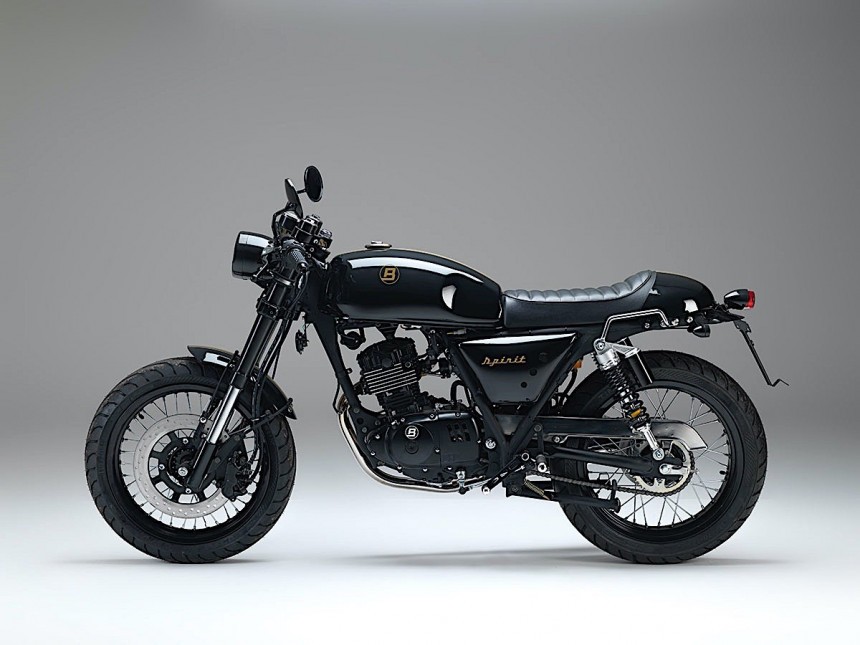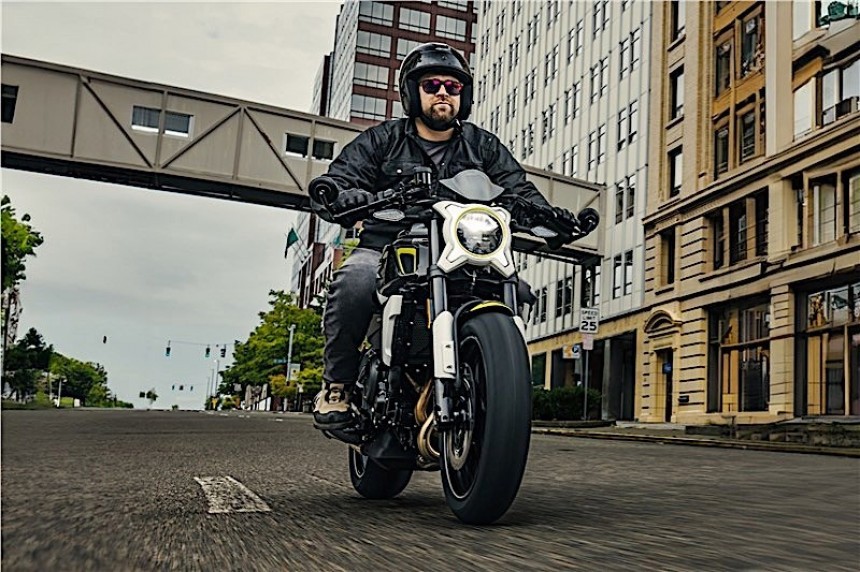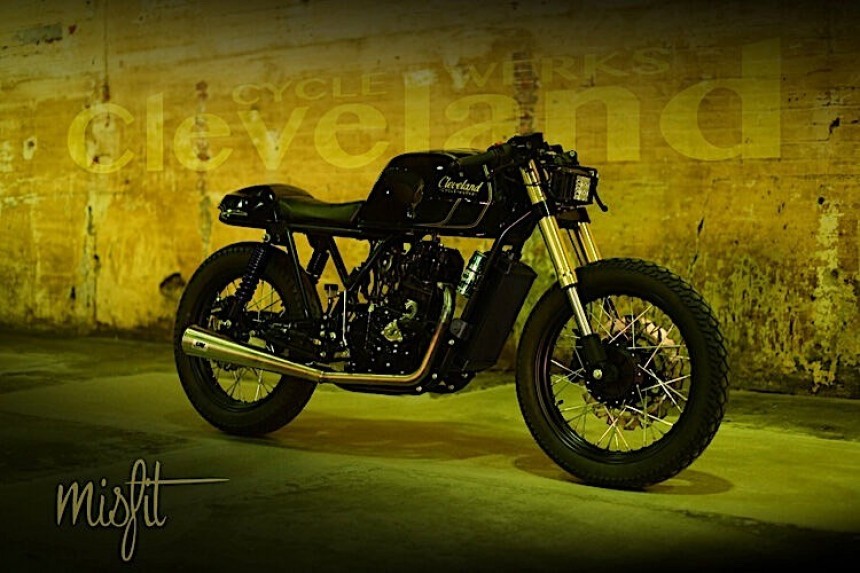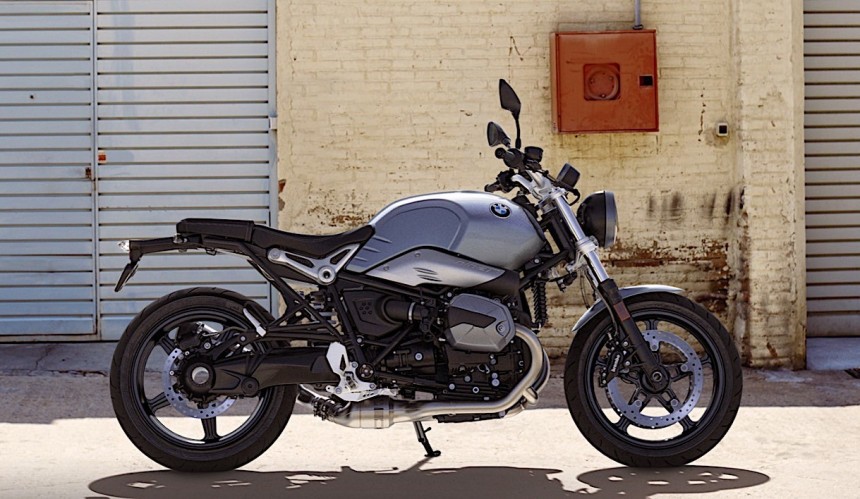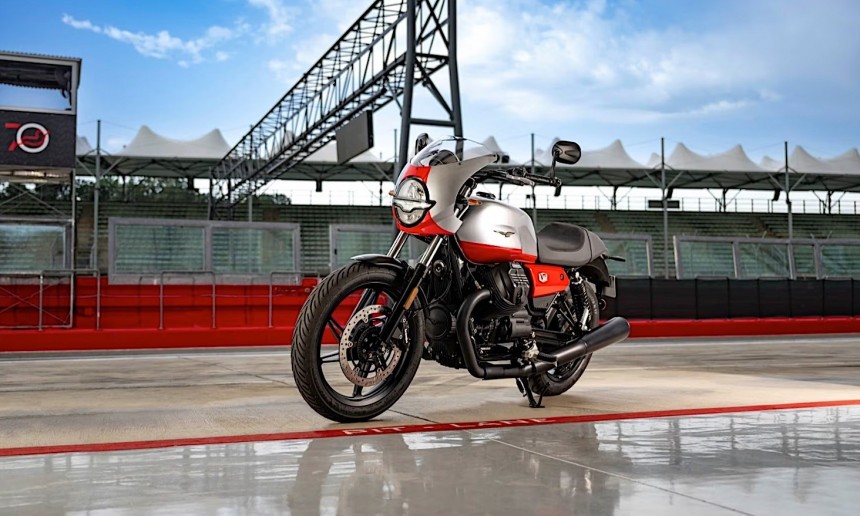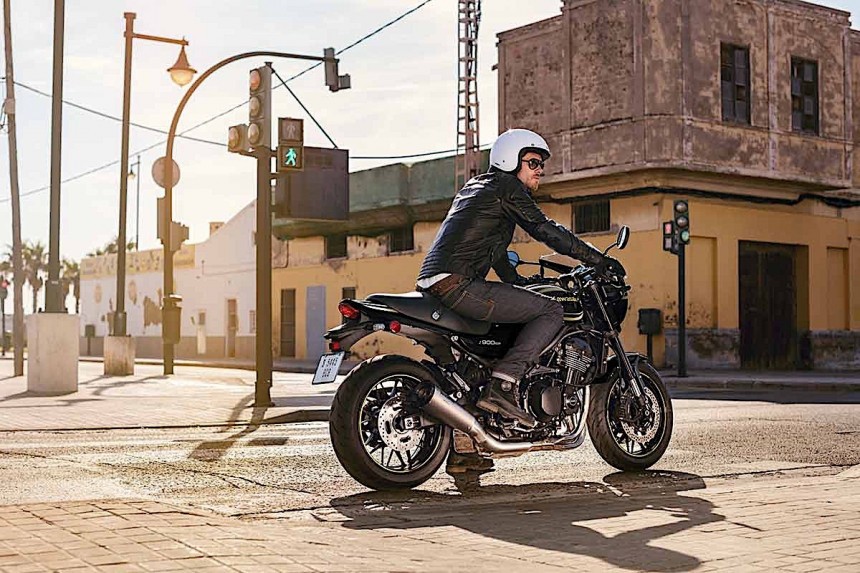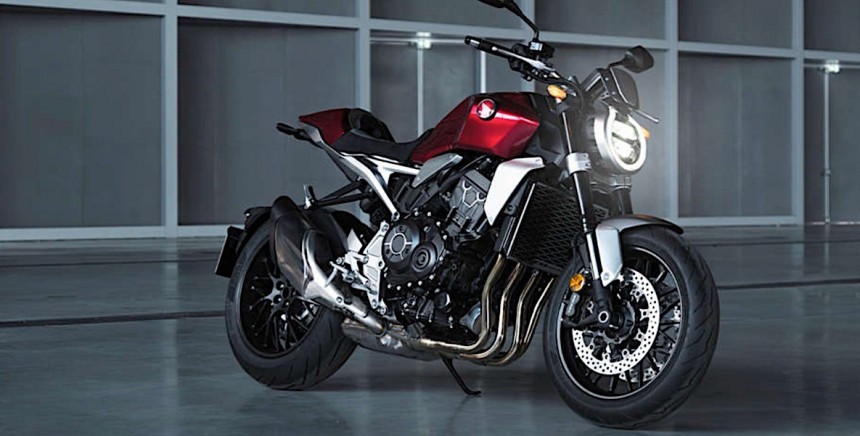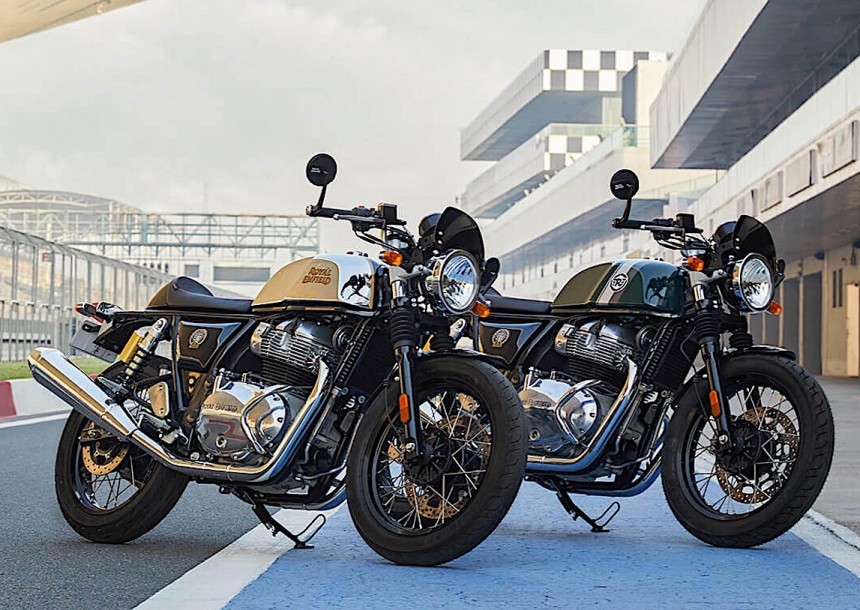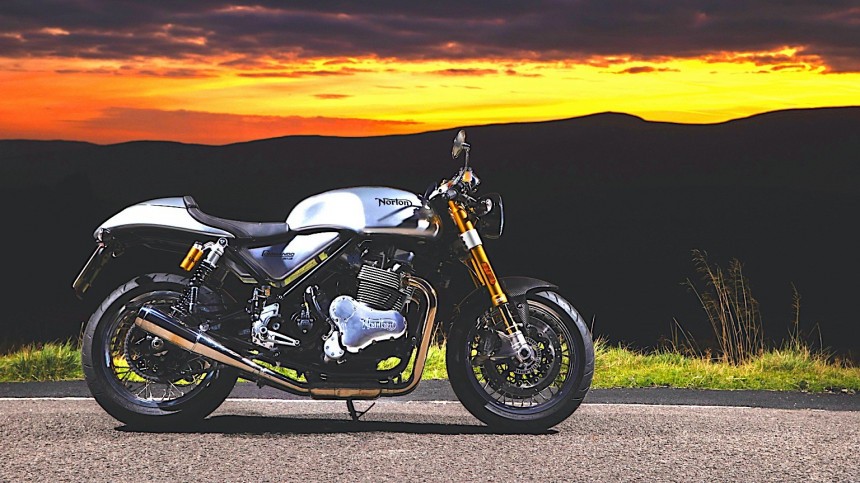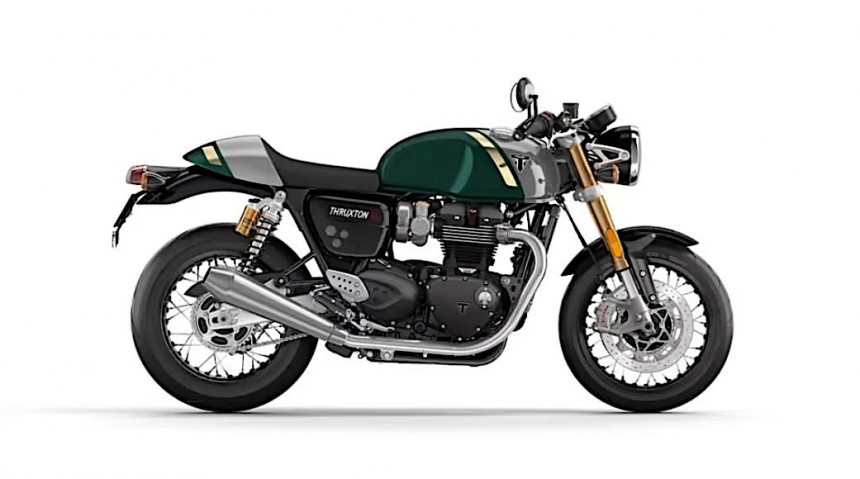A couple of weeks ago we started taking a closer look at a motorcycle breed the world has got to know over the years as café racers. In that story we focused on the initial bikes, the ones that started the movement. Now it's time to take a look at the modern-day beasts.
Café racers originated in the Britain of the 1950s and 1960s, at the initiative of that time's group of youngsters known as the Ton-Up boys (or, alternatively, Rockers or leather boys). Not wealthy enough to afford cars, but certainly wealthy enough to hang around café shops, these guys and gals needed means of transportation that could rapidly take them from café to café, to where the fun was.
Most of them had bikes for the task, but as they came out the factory doors they weren't fast enough for the task at hand. So people started stripping them down and modifying them to be faster. There's even a legend (more of a myth, really) saying that the ultimate goal of such a bike conversion was to allow its rider to travel between cafes in the time it took for a song to run on the jukebox.
The style was so admired that it spread like wildfire. What started as something people did in their own garages turned into businesses, and quickly drew the attention of established bike makers. Some of them, the ones most impacted by the movement, decided to give the public what they wanted, in the form of ready-made café racers.
And they still do to this day, even if over time, and due to the requirements of brand image, production café racers have suffered significant modifications.
Generally, a café racer should be stripped down to a bare minimum, with no side covers, or chain cover, or even fenders. The only things it needs to run are a frame, an engine, two wheels, and a seat for one.
But, as said, some of those basic requirements got diluted over time, and that's not necessarily what we get today, in the bikes sold from and advertised by dealers as café racers, or some other related style. Yet the commonalities between the production bikes of today aspiring to the title and the style that spawned them are still there, and very much so in the 15 bikes that follow.
Historically speaking, at least as far as café racers go, the name BSA is of utmost importance. The acronym stands for Birmingham Small Arms Company, and it once was an organization that made anything from machine guns to buses.
BSA played an important role in the birth of the café racer style through something called the TriBSA. That was an unsanctioned bike made by British riders using Triumph engines and BSA frames.
This product was so successful that, after in 1973 BSA, Triumph, and Norton-Villiers more or less became the same company, an official production run of the TriBSA was considered. For reasons unknown, that didn't happen.
At the time of writing BSA is a marginally important bike maker at best. It only has one model to show for, the Gold Star, and it doesn't even officially advertise it as a café racer.
The bike is powered by a single-cylinder 652cc engine rated at just 45 horsepower. It may not seem like much, but for a bike that weighs just 213 kg (470 pounds) that's probably more than enough.
The bike is not exactly styled as a true café racer, as it comes with large fenders over both wheels, the fuel tank is not as pronounced as we're used to, and the seat is a lot more toned down. Because of this, we've decided to rank the Gold Star last on our list.
BSA offers the model in two versions, standard and Legacy Edition, for prices that start at £6,500 ($8,000). The bike is only available in the UK and the Philippines.
Another British bike maker it's likely you've never heard of is CCM. That's short for Clews Competition Machines, and they have been around ever since the 1970s, a time when café racers already had a strong grip on the market.
CCM presently has a relatively strong portfolio, selling bikes made for the bobber, roadster, and endurance segments. It doesn't officially list any of its bikes as café racers, but it's not hard to find traces of one in several of its models.
We've selected the Maverick to include in our list for several reasons. The first would be the quintessential café racer look of the two-wheeler, with an almost perfect straight back linking the two tiny fenders together, the lack of any noticeable cover on the 54 hp, 600cc engine and its components, and an absolutely vintage feel.
What doesn't quite fit with the description are the two tires wrapped around the wheel, clearly meant to handle rougher terrain than what a busy London street would have to offer.
We understand the bike was built as a sort of tribute to the motorcycle shown in the sci-fi movie Infinit (starring Mark Wahlberg, Chiwetel Ejiofor, and Sophie Cookson), but that's not reflected in the price of the ride: it sells for £10,685 ($13,130) for the base version (two more, Premium and Ultimate are also available).
Although they were mostly a European affair, café racers didn't go unnoticed by the big Japanese bike makers. In fact some of them, Yamaha included, have been on board with the movement ever since the beginning. Some of you might remember the factory-made SRX600 of that period as one of the first production motorcycles in this style.
Presently Yamaha does not sell a purpose-built café racer, but many consider the XSR900 as a perfect incarnation of one.
The model is officially a neo-retro two-wheeler that came about in the mid-2010s. Its maker officially describes it as the ultimate heritage roadster, but its distinctive styling, which blends a big fuel tank with an exposed engine and minor decorations elsewhere, makes it a suitable entry in our list.
The bike is powered by an 890cc 3-cylinder engine rated at 117 hp and tied to a 6-speed transmission. This one, with a more toned-down café racer look than anything else on our list, sells in the U.S. as well, where it goes for $10,199.
Australia is not a country famous for the cars and bikes it makes, because such native machines are almost non-existent. Yet the advancements made in the two industries these past few years did give birth to a series of startups in the business of making vehicles.
Savic is one of them, a group that set out to design the "future of high-performance electric motorcycles." There's only one model in its portfolio at the moment, and coincidentally it's shaped to look very much like a 1970s British café racer.
The bike is called C-Series, and it's the first of several electric motorcycles that made it into our little list here. Meant to offer its riders a classic riding experience, it comes in two variants, Alpha and Delta, with significant performance differences.
It's the Alpha that sits at the top of the food chain, providing a 16.3 kWh battery good for over 200 km of travel (124 miles) and an electric motor delivering 80 horsepower and 200 Nm of torque.
The bike is not yet fully out, but it can be pre-ordered. The overall price is known, with Savic demanding an astounding $26,990. Given how that's probably Australian dollars, you can expect to land yourself a Savic C-Series Alpha for $17,000.
The second electric bike to make it in our list of 15 production café racer bikes is the Tarform Luna. Admittedly, that is also a bit of a stretch, seeing how the ride is not yet in massive, full production, but given how you can already order one, why not?
Tarform too is a startup, only it's one based in America, and on the café racer front that's a very rare thing indeed. The company is based in New York, and its stated goal is to create "a new breed of electric motorcycle."
That breed starts with the Luna, of which two design styles are on the table, a scrambler and a racer. At the core of both sits an 11.2 kWh battery and a 75 hp electric motor. They give the bike a range of just 100 miles (161 km, more than enough to travel confidently between café shops) and an acceleration time to 60 mph of 3.8 seconds.
The electric bike with café racer styling and wheels more suitable for off-road ridings can be had for prices starting at $44,000. There's a bit of waiting to be done until you can get one, as Tarform says the production capability for 2023 has been reached. The crew does take reservations for next year though.
If you're looking for a very retro-styled yet modern café racer, then the Bluroc Spirit 125 is the one for you. You might have not heard of it before, but here's everything you need to know.
Bluroc is based in Belgium, another country that literally lacks any kind of fame in the automotive industry (not taking into account the several car plants of foreign brands based there). It's quite a prolific company, with no less than ten different bike models on the table.
Of interest to us is the Spirit 125, a "small café-racer full of character" that looks like it time-traveled right from the 1970s.
The bike is available in two color schemes, Gold Black and Racing Green, and with the same tiny 125 cc single-cylinder engine in the frame. It is only capable of developing 11 hp, but for something that weighs about as much as a well-built human (115 kg/254 pounds) that's probably more than suitable.
The bike maker does not list an official price for the ride (which, as far as we can tell, it's only available in the EU), but other sellers do and they say it's going for around £3,000, which is about $3,700 at today's exchange rates.
Another bike maker that did not exist at the time when café racers came about is CFMoto. These guys are Chinese by birth, and ever since the country has made a name for itself internationally as a production powerhouse, they're quite present elsewhere as well.
The company was established in 1989, and has grown since to make anything from engines to yachts. It's the motorcycles made under the name that have taken CFMoto global. There are 17 models to be had in total, with the 700CL-X Sport taking center stage for the purposes of our story.
A sport bike dressed in a café racer aesthetic, the ride provides 74 horsepower from a 693cc parallel-twin engine (quite a rare option in this segment). The engine spins 17-inch wheels and is brought to a halt by means of Brembo braking hardware.
Unlike some of the previous beauties, the 700CL-X Sport can be had stateside, and for rather affordable prices: the Chinese are only charging $7,399 for one.
Cleveland CycleWerks is one of the few small American bike makers that try to challenge the supremacy of giants Harley-Davidson and Indian. The company is relatively new, having been established in 2009 in Ohio, but unlike most of the businesses born in modern times, it does not do business in the electric motorcycle segment.
Instead, these guys rely on Chinese-made bike components and most of the time Honda engines to locally assemble bikes in styles and for segments Americans are not generally used to.
Just four models are presently part of Cleveland's portfolio, namely the Ace, Misfit, Mutiny, and Hooligun. Of them, the Ace and the Misfit are the most café racer-like.
We chose the latter to include in our selection because it is the more pretentious of the bunch, both as far as the mechanical bits go, and price-wise.
The Misfit is a ride that can be had with either a 250cc engine in the frame or a 400cc one. The main differences are the power output (17 hp vs 28 hp), the paint job, and not so much the price tag.
Only $100 separates the two rides, the former selling for $5,199 and the latter for $5,299.
As we move closer to the number one position in our list, the heavyweights of the industry start coming into focus. The first we stumble upon: BMW.
The German brand too is one of the names that have been playing the café racer game since almost the beginning, but first and foremost it established itself as the main supplier of stock bikes that get converted into café racers at the hands of custom shops.
Although it officially doesn't call them as such, but has them listed as heritage models, BMW's go-to production café racers are the R nineTs. A mix between that style and scrambler, the Pure version is the closest you can get to a British-styled 1960s bike in the current portfolio.
Described as a purist and reduced bike, which is exactly what café racers strive to be, the bike rocks a huge engine compared to what we've seen so far, a 1,170cc monster rated at 85 lbs-ft of torque.
The design of the ride is purely German, with a massive fuel tank rising above the frame that holds the largely uncovered engine. A small fender at the front, and a raised one at the rear (made so as to give the bike an almost straight back) are all there is to it.
BMW is selling the R nineT Pure in the U.S. for a very affordable price, just $10,995.
There are several high-profile Italian bike makers in the world today, but only one of them deserves to be mentioned in our story: Moto Guzzi.
Although located quite far from the UK, the Italians were quick to jump on the café racer train, and started making production bikes in this style right from 1976. They started with something called the Le Mans, a bike that needs little introduction even today, more than three decades after it was discontinued.
Presently Moto Guzzi produces less bike models than some of the startups we've discussed above: just four of them are available. Of them all, the V7 is today the most café racer, followed in some respects by the V9.
The V7 traces its roots all the way back to 1971, but in its current form, it only dates back to 2021 (the original was only made for a couple of years more than half a century ago). As such, it comes with the most modern of appointments, in a package that looks both modern and retro at the same time.
At the core of the two-wheeler is a 850cc transverse 90-degree engine sitting inside a chassis with steel elements, backed by Kayaba shock absorbers.
Moto Guzzi has four V7 versions on the table, namely the Stone, Special Edition, Special, and Stone Corsa, with minor styling differences and major paint job changes differentiating them. Prices for any of them sit at around $9,000, making them solid choices for anyone looking for a café racer bike that can really trace its roots to the early years of the style.
For a long time however the Japanese have not had a dedicated café racer to offer off the factory floor. That's no longer the case, as the Z900RS Café was purpose-built for the task.
Selling as the "retro revolution" bike all have been waiting for, the two-wheeler is powered by a 948cc four-cylinder engine tied to a six-speed transmission. It doesn't exactly look like a standard café racer, on account of the headlight fairing up front and the rather large fender over the wheel there, but I'm pretty sure few riders mind those elements as much as you'd think.
Especially considering how the motorcycle retails from just $12,399, and has the entire might of Kawasaki behind it.
It's the latter family we've chosen for our list, more specifically the CB1000R. The ride is advertised as a sport naked with a minimalist café racer styling, a sort of neo sports café if you will.
A bit bulkier and a lot sharper than regular bikes of this kind, the Japanese two-wheeler spins cast aluminum wheels with the power provided by a 998cc engine rated at a huge 143 hp. That's the kind of displacement and power initial makers of café racers would probably have loved to have on their hands.
At the time of writing the Honda CB1000R is offered in Europe in three color choices and two versions, standard and Black Edition. Pricing for the cheapest of them starts at £11,749, which would be the equivalent of over $14,300 at present-day exchange rates.
Royal Enfield is a historically important British-born bike maker, and it will forever remain so even if in its current incarnation is more Indian than European. As such, it perfectly understands what a café racer should be like.
The Continental GT 650 is the perfect expression of that understanding, "a ton of fun" on two wheels designed to be a nod to what the British civilians of the 1960s were able to achieve.
The machine is the perfect definition of a café racer, with two fat wheels supporting a simple frame. Inside it there is a small and unpretentious 648cc engine with exhaust pipes on either side and good for 47 horsepower, above it sits a large fuel tank that can be had in five distinct colors, and a small, perfectly straight seat. And that's about it.
Adding to the appeal and not-to-be-ignored capabilities is the ride's price. On the American market, Royal Enfield is only asking from $6,349 for one.
Norton has been at the core of the café racer style, as it supplied the Featherbed frame and transmission for the Triumph-engined Triton. That's a mutant bike that is considered by many the first true café racer.
Today's Commando (the family was born all the way back in the 1960s) tries to be a nod to that bike as much as possible. It now uses a hand TIG and MIG welded frame inside which a 961cc parallel twin engine sits, ready to throw almost 77 hp of power at the tarmac.
On a visual level, the bike is as pure of a café racer as you can get: simple, elegant, effective. So much so, in fact, that it might have you wondering how can this be a production motorcycle. Well, it can, and the around $18,000 asking price kind of makes that painfully clear.
So it's no wonder that the bike maker has the audacity to described the present-day Thruxton RS as the "original modern café racer."
Just like the other two that preceded it in our list, the Thruxton RS comes in a simple and unassuming body style, built for functionality but still managing to look like some custom ride cooked in an important garage.
There's a massive (compared with some of the other names here) 1,200cc engine in the tubular steel frame, 103 horsepower to be sent to the 17-inch aluminum wheels, and a large, 3.8-gallon (14.5 liters) fuel tank to keep it going for long distances.
This king of all modern-day production café racers is however not the most expensive. All an American would have to spend to get himself one is $16,995.
Most of them had bikes for the task, but as they came out the factory doors they weren't fast enough for the task at hand. So people started stripping them down and modifying them to be faster. There's even a legend (more of a myth, really) saying that the ultimate goal of such a bike conversion was to allow its rider to travel between cafes in the time it took for a song to run on the jukebox.
The style was so admired that it spread like wildfire. What started as something people did in their own garages turned into businesses, and quickly drew the attention of established bike makers. Some of them, the ones most impacted by the movement, decided to give the public what they wanted, in the form of ready-made café racers.
And they still do to this day, even if over time, and due to the requirements of brand image, production café racers have suffered significant modifications.
Generally, a café racer should be stripped down to a bare minimum, with no side covers, or chain cover, or even fenders. The only things it needs to run are a frame, an engine, two wheels, and a seat for one.
But, as said, some of those basic requirements got diluted over time, and that's not necessarily what we get today, in the bikes sold from and advertised by dealers as café racers, or some other related style. Yet the commonalities between the production bikes of today aspiring to the title and the style that spawned them are still there, and very much so in the 15 bikes that follow.
15. BSA Gold Star
BSA played an important role in the birth of the café racer style through something called the TriBSA. That was an unsanctioned bike made by British riders using Triumph engines and BSA frames.
This product was so successful that, after in 1973 BSA, Triumph, and Norton-Villiers more or less became the same company, an official production run of the TriBSA was considered. For reasons unknown, that didn't happen.
At the time of writing BSA is a marginally important bike maker at best. It only has one model to show for, the Gold Star, and it doesn't even officially advertise it as a café racer.
The bike is powered by a single-cylinder 652cc engine rated at just 45 horsepower. It may not seem like much, but for a bike that weighs just 213 kg (470 pounds) that's probably more than enough.
The bike is not exactly styled as a true café racer, as it comes with large fenders over both wheels, the fuel tank is not as pronounced as we're used to, and the seat is a lot more toned down. Because of this, we've decided to rank the Gold Star last on our list.
BSA offers the model in two versions, standard and Legacy Edition, for prices that start at £6,500 ($8,000). The bike is only available in the UK and the Philippines.
14. CCM Maverick
CCM presently has a relatively strong portfolio, selling bikes made for the bobber, roadster, and endurance segments. It doesn't officially list any of its bikes as café racers, but it's not hard to find traces of one in several of its models.
We've selected the Maverick to include in our list for several reasons. The first would be the quintessential café racer look of the two-wheeler, with an almost perfect straight back linking the two tiny fenders together, the lack of any noticeable cover on the 54 hp, 600cc engine and its components, and an absolutely vintage feel.
What doesn't quite fit with the description are the two tires wrapped around the wheel, clearly meant to handle rougher terrain than what a busy London street would have to offer.
We understand the bike was built as a sort of tribute to the motorcycle shown in the sci-fi movie Infinit (starring Mark Wahlberg, Chiwetel Ejiofor, and Sophie Cookson), but that's not reflected in the price of the ride: it sells for £10,685 ($13,130) for the base version (two more, Premium and Ultimate are also available).
13. Yamaha XSR900
Presently Yamaha does not sell a purpose-built café racer, but many consider the XSR900 as a perfect incarnation of one.
The model is officially a neo-retro two-wheeler that came about in the mid-2010s. Its maker officially describes it as the ultimate heritage roadster, but its distinctive styling, which blends a big fuel tank with an exposed engine and minor decorations elsewhere, makes it a suitable entry in our list.
The bike is powered by an 890cc 3-cylinder engine rated at 117 hp and tied to a 6-speed transmission. This one, with a more toned-down café racer look than anything else on our list, sells in the U.S. as well, where it goes for $10,199.
12. Savic C-Series
Savic is one of them, a group that set out to design the "future of high-performance electric motorcycles." There's only one model in its portfolio at the moment, and coincidentally it's shaped to look very much like a 1970s British café racer.
The bike is called C-Series, and it's the first of several electric motorcycles that made it into our little list here. Meant to offer its riders a classic riding experience, it comes in two variants, Alpha and Delta, with significant performance differences.
It's the Alpha that sits at the top of the food chain, providing a 16.3 kWh battery good for over 200 km of travel (124 miles) and an electric motor delivering 80 horsepower and 200 Nm of torque.
The bike is not yet fully out, but it can be pre-ordered. The overall price is known, with Savic demanding an astounding $26,990. Given how that's probably Australian dollars, you can expect to land yourself a Savic C-Series Alpha for $17,000.
11. Tarform Luna
Tarform too is a startup, only it's one based in America, and on the café racer front that's a very rare thing indeed. The company is based in New York, and its stated goal is to create "a new breed of electric motorcycle."
That breed starts with the Luna, of which two design styles are on the table, a scrambler and a racer. At the core of both sits an 11.2 kWh battery and a 75 hp electric motor. They give the bike a range of just 100 miles (161 km, more than enough to travel confidently between café shops) and an acceleration time to 60 mph of 3.8 seconds.
The electric bike with café racer styling and wheels more suitable for off-road ridings can be had for prices starting at $44,000. There's a bit of waiting to be done until you can get one, as Tarform says the production capability for 2023 has been reached. The crew does take reservations for next year though.
10. Bluroc Spirit 125
Bluroc is based in Belgium, another country that literally lacks any kind of fame in the automotive industry (not taking into account the several car plants of foreign brands based there). It's quite a prolific company, with no less than ten different bike models on the table.
Of interest to us is the Spirit 125, a "small café-racer full of character" that looks like it time-traveled right from the 1970s.
The bike is available in two color schemes, Gold Black and Racing Green, and with the same tiny 125 cc single-cylinder engine in the frame. It is only capable of developing 11 hp, but for something that weighs about as much as a well-built human (115 kg/254 pounds) that's probably more than suitable.
The bike maker does not list an official price for the ride (which, as far as we can tell, it's only available in the EU), but other sellers do and they say it's going for around £3,000, which is about $3,700 at today's exchange rates.
9. CFMoto 700CL-X Sport
The company was established in 1989, and has grown since to make anything from engines to yachts. It's the motorcycles made under the name that have taken CFMoto global. There are 17 models to be had in total, with the 700CL-X Sport taking center stage for the purposes of our story.
A sport bike dressed in a café racer aesthetic, the ride provides 74 horsepower from a 693cc parallel-twin engine (quite a rare option in this segment). The engine spins 17-inch wheels and is brought to a halt by means of Brembo braking hardware.
Unlike some of the previous beauties, the 700CL-X Sport can be had stateside, and for rather affordable prices: the Chinese are only charging $7,399 for one.
8. Cleveland Misfit
Instead, these guys rely on Chinese-made bike components and most of the time Honda engines to locally assemble bikes in styles and for segments Americans are not generally used to.
Just four models are presently part of Cleveland's portfolio, namely the Ace, Misfit, Mutiny, and Hooligun. Of them, the Ace and the Misfit are the most café racer-like.
We chose the latter to include in our selection because it is the more pretentious of the bunch, both as far as the mechanical bits go, and price-wise.
The Misfit is a ride that can be had with either a 250cc engine in the frame or a 400cc one. The main differences are the power output (17 hp vs 28 hp), the paint job, and not so much the price tag.
Only $100 separates the two rides, the former selling for $5,199 and the latter for $5,299.
7. BMW R nineT Pure
The German brand too is one of the names that have been playing the café racer game since almost the beginning, but first and foremost it established itself as the main supplier of stock bikes that get converted into café racers at the hands of custom shops.
Although it officially doesn't call them as such, but has them listed as heritage models, BMW's go-to production café racers are the R nineTs. A mix between that style and scrambler, the Pure version is the closest you can get to a British-styled 1960s bike in the current portfolio.
Described as a purist and reduced bike, which is exactly what café racers strive to be, the bike rocks a huge engine compared to what we've seen so far, a 1,170cc monster rated at 85 lbs-ft of torque.
The design of the ride is purely German, with a massive fuel tank rising above the frame that holds the largely uncovered engine. A small fender at the front, and a raised one at the rear (made so as to give the bike an almost straight back) are all there is to it.
BMW is selling the R nineT Pure in the U.S. for a very affordable price, just $10,995.
6. Moto Guzzi V7
Although located quite far from the UK, the Italians were quick to jump on the café racer train, and started making production bikes in this style right from 1976. They started with something called the Le Mans, a bike that needs little introduction even today, more than three decades after it was discontinued.
Presently Moto Guzzi produces less bike models than some of the startups we've discussed above: just four of them are available. Of them all, the V7 is today the most café racer, followed in some respects by the V9.
The V7 traces its roots all the way back to 1971, but in its current form, it only dates back to 2021 (the original was only made for a couple of years more than half a century ago). As such, it comes with the most modern of appointments, in a package that looks both modern and retro at the same time.
At the core of the two-wheeler is a 850cc transverse 90-degree engine sitting inside a chassis with steel elements, backed by Kayaba shock absorbers.
Moto Guzzi has four V7 versions on the table, namely the Stone, Special Edition, Special, and Stone Corsa, with minor styling differences and major paint job changes differentiating them. Prices for any of them sit at around $9,000, making them solid choices for anyone looking for a café racer bike that can really trace its roots to the early years of the style.
5. Kawasaki Z900RS Café
Like some other Japanese bike makers, Kawasaki too was on board with the café racer movement right from the beginning. Not directly, through some factory-made bikes, but thanks to the fact people often turned to its engines when it came to fitting their rides in accordance with the criteria of the genre.For a long time however the Japanese have not had a dedicated café racer to offer off the factory floor. That's no longer the case, as the Z900RS Café was purpose-built for the task.
Selling as the "retro revolution" bike all have been waiting for, the two-wheeler is powered by a 948cc four-cylinder engine tied to a six-speed transmission. It doesn't exactly look like a standard café racer, on account of the headlight fairing up front and the rather large fender over the wheel there, but I'm pretty sure few riders mind those elements as much as you'd think.
Especially considering how the motorcycle retails from just $12,399, and has the entire might of Kawasaki behind it.
4. Honda CB1000R
Honda engines too have always been favorites in the custom motorcycle world, being consistently fitted into the frames of city-dwelling motorcycles. These guys however were among the first to adopt the styling on production bikes, at first on the domestic market with the GBs of the 1980s, and later with the CBs.It's the latter family we've chosen for our list, more specifically the CB1000R. The ride is advertised as a sport naked with a minimalist café racer styling, a sort of neo sports café if you will.
A bit bulkier and a lot sharper than regular bikes of this kind, the Japanese two-wheeler spins cast aluminum wheels with the power provided by a 998cc engine rated at a huge 143 hp. That's the kind of displacement and power initial makers of café racers would probably have loved to have on their hands.
At the time of writing the Honda CB1000R is offered in Europe in three color choices and two versions, standard and Black Edition. Pricing for the cheapest of them starts at £11,749, which would be the equivalent of over $14,300 at present-day exchange rates.
3. Royal Enfield Continental GT 650
The top three positions on our list are occupied by traditional British companies. After all, it's their bikes that started all this, so they should deserve the credit.Royal Enfield is a historically important British-born bike maker, and it will forever remain so even if in its current incarnation is more Indian than European. As such, it perfectly understands what a café racer should be like.
The Continental GT 650 is the perfect expression of that understanding, "a ton of fun" on two wheels designed to be a nod to what the British civilians of the 1960s were able to achieve.
The machine is the perfect definition of a café racer, with two fat wheels supporting a simple frame. Inside it there is a small and unpretentious 648cc engine with exhaust pipes on either side and good for 47 horsepower, above it sits a large fuel tank that can be had in five distinct colors, and a small, perfectly straight seat. And that's about it.
Adding to the appeal and not-to-be-ignored capabilities is the ride's price. On the American market, Royal Enfield is only asking from $6,349 for one.
2. Norton Commando 961 Café Racer
Taking the second spot in our little list is Norton, with the Commando 961 Café Racer. It's the only bike on our list to actually be named after the genre it's meant to represent, but that's not why we included it so high up.Norton has been at the core of the café racer style, as it supplied the Featherbed frame and transmission for the Triumph-engined Triton. That's a mutant bike that is considered by many the first true café racer.
Today's Commando (the family was born all the way back in the 1960s) tries to be a nod to that bike as much as possible. It now uses a hand TIG and MIG welded frame inside which a 961cc parallel twin engine sits, ready to throw almost 77 hp of power at the tarmac.
On a visual level, the bike is as pure of a café racer as you can get: simple, elegant, effective. So much so, in fact, that it might have you wondering how can this be a production motorcycle. Well, it can, and the around $18,000 asking price kind of makes that painfully clear.
1. Triumph Thruxton RS
In any list of production café racers there should be no other number 1 than Triumph. The name is virtually the one around which the movement was built, being a major supplier of components for the Triton, but also for another iconic bike of the early years, the BSA hybrid called TriBSA.So it's no wonder that the bike maker has the audacity to described the present-day Thruxton RS as the "original modern café racer."
Just like the other two that preceded it in our list, the Thruxton RS comes in a simple and unassuming body style, built for functionality but still managing to look like some custom ride cooked in an important garage.
There's a massive (compared with some of the other names here) 1,200cc engine in the tubular steel frame, 103 horsepower to be sent to the 17-inch aluminum wheels, and a large, 3.8-gallon (14.5 liters) fuel tank to keep it going for long distances.
This king of all modern-day production café racers is however not the most expensive. All an American would have to spend to get himself one is $16,995.
